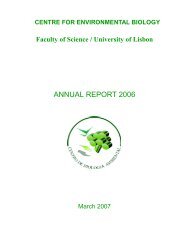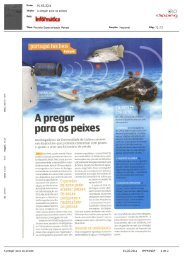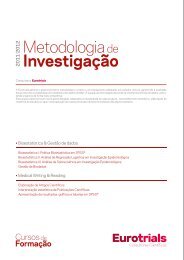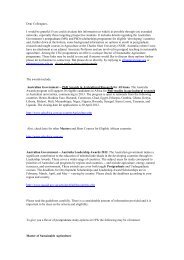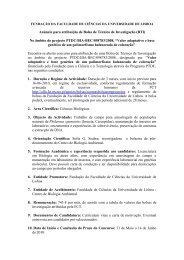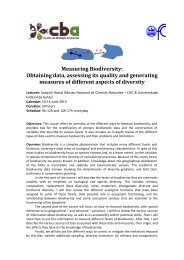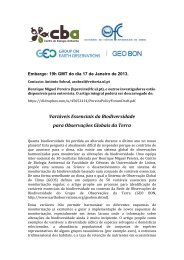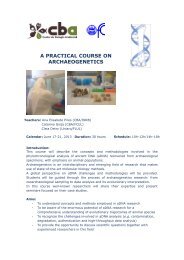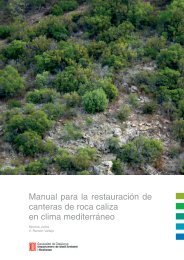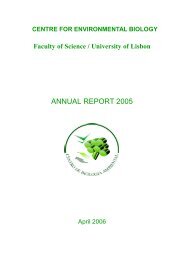European Red List of Vascular Plants - European Commission
European Red List of Vascular Plants - European Commission
European Red List of Vascular Plants - European Commission
Create successful ePaper yourself
Turn your PDF publications into a flip-book with our unique Google optimized e-Paper software.
level, and species complexes have been split into multiple<br />
species. Therefore, the taxonomy used in the <strong>European</strong><br />
<strong>Red</strong> <strong>List</strong> <strong>of</strong> <strong>Vascular</strong> <strong>Plants</strong> is not concurrent with all the<br />
recent developments and in some cases reflects the available<br />
taxonomic knowledge at the time <strong>of</strong> assessment.<br />
The situation is made even more complicated by the<br />
molecular work that has been conducted on flowering<br />
plants by a team <strong>of</strong> researchers across the world (known<br />
as the Angiosperm Phylogeny Group – APG) in recent<br />
years. Based on the findings from both molecular and<br />
morphological studies the APG team have been developing<br />
a new and completely revised phylogeny <strong>of</strong> the world’s<br />
plants. The latest version <strong>of</strong> this phylogenetic arrangement,<br />
known as APG3, has gained widespread acceptance across<br />
the botanical community with many herbaria rearranging<br />
their collections to match this new treatment. The new<br />
treatment has resulted in the complete reordering <strong>of</strong> plant<br />
Orders and Families, new Families have been created, some<br />
have been lumped and genera have been moved between<br />
them and in some cases even split between families.<br />
The IUCN <strong>Red</strong> <strong>List</strong> has up until now been using the<br />
more traditional approach followed at RBG Kew which<br />
involved a mixture <strong>of</strong> Cronquist’s Orders and Brummitt’s<br />
treatment <strong>of</strong> Families and Genera. This has been mainly<br />
followed in this project but not exclusively. However, now<br />
that the APG approach has reached a fairly stable point<br />
and is widely accepted and used, it is envisaged that this<br />
approach will be followed by the IUCN <strong>Red</strong> <strong>List</strong>. When<br />
this happens, it will have consequences for the <strong>European</strong><br />
<strong>Red</strong> <strong>List</strong> <strong>of</strong> <strong>Vascular</strong> <strong>Plants</strong> as the numbers <strong>of</strong> species<br />
previously recorded in various Genera, Families and Orders<br />
will change considerably as the changes are implemented.<br />
Distinct subspecies were only assessed as part <strong>of</strong> this<br />
project when they were listed in the EC Habitats Directive<br />
or the Bern Convention, or in cases where a species is only<br />
represented in its wild form at subspecies level. However,<br />
due to the taxonomic developments described above, a<br />
few species selected in 2008 have since been reclassified as<br />
subspecies and are therefore included in this <strong>Red</strong> <strong>List</strong>. Other<br />
species from the original selection were discarded during<br />
the assessment process as they were not taxonomically<br />
valid anymore. More notes on the taxonomy followed for<br />
the specific groups can be found in chapters 3, 4 and 5.<br />
■■<br />
■■<br />
■■<br />
■■<br />
■■<br />
■■<br />
■■<br />
■■<br />
■■<br />
Geographic range (including a distribution map)<br />
<strong>Red</strong> <strong>List</strong> Category and Criteria<br />
Population information<br />
Habitat preferences<br />
Use and trade information<br />
Major threats<br />
Conservation measures<br />
Other general information<br />
Key literature references<br />
2.5 Review workshop and evaluation <strong>of</strong><br />
assessments<br />
Two workshops involving around 25 national and taxon<br />
experts each were organised on 12-16 April 2010 in<br />
Cascais/Portugal for crop wild relatives and 21-24 June<br />
2010 in Brest/France for the policy and a selection<br />
<strong>of</strong> the aquatic plant species. During the workshops,<br />
focussed working groups were organised to discuss the<br />
preliminary assessments and to add new information to<br />
the species summaries and maps. <strong>Red</strong> <strong>List</strong> Categories<br />
were then defined for each species at the <strong>European</strong> and<br />
EU 27 levels.<br />
Following the review workshop, the data were edited,<br />
and outstanding questions were resolved through<br />
communications with the experts. Consistency in the<br />
use <strong>of</strong> IUCN Criteria was checked by IUCN staff from<br />
the IUCN <strong>Red</strong> <strong>List</strong> Unit. The resulting finalised IUCN<br />
<strong>Red</strong> <strong>List</strong> assessments are a product <strong>of</strong> scientific consensus<br />
concerning species status and are backed by relevant<br />
literature and data sources.<br />
Chaenorhinum serpyllifolium ssp. lusitanicum is endemic to the southwestern coast <strong>of</strong><br />
Portugal, occupying an area smaller than 300 km². The subpopulations are isolated<br />
and this fragmentation will increase due to the high pressure from urban and tourism<br />
development at the coast. It is therefore listed as Endangered. Photograph © Pedro<br />
Arsénio.<br />
2.4 Assessment protocol<br />
For the selected plant species that are part <strong>of</strong> this study,<br />
the following data were entered into the database (IUCN<br />
Species Information Service – SIS):<br />
■■ Species’ taxonomic classification<br />
6



